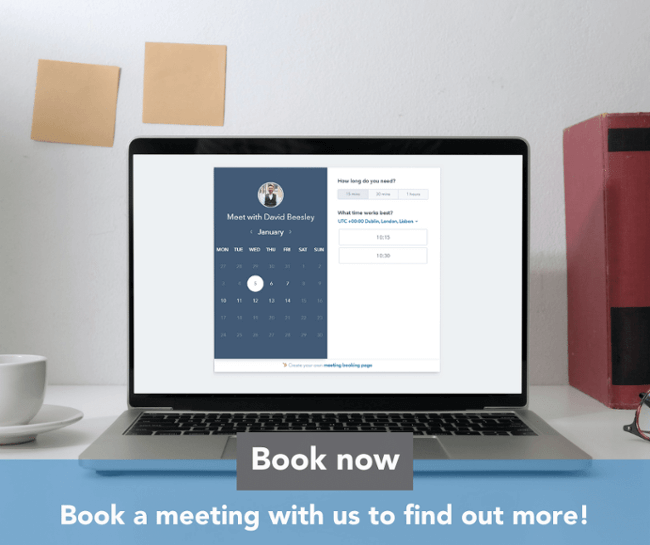For the longest time there was a school of thought that PR, Marketing, SEO, website management and paid advertising operate in isolation. Yes, now and again each discipline might cross paths, but for the most part they would operate independently with perhaps only the Chief Marketing Officer being in the position to have a holistic view of activity.

However, this is not how we see the world of Inbound PR. Our paths don’t cross from time to time – we’re on the same journey and we can use each other’s area of expertise to achieve the same goal – more awareness, more leads, more business.
So, if your expertise is in PR and not in managing paid media campaigns, we’ve provided some pointers so that you can start to understand the different elements involved and how they feed into an integrated Inbound PR campaign.
Do your homework
First thing – check your buyer persona(s). Dig out the document that you invested so much time and effort in at the start of your communications campaign and remind yourself of your ideal buyer. Having the persona at the heart of what you do, whether it’s Earned, Owned or Paid media, will be valuable to making sure you’re targeting the right audience and not just throwing money away.
The advice that follows is assuming that you have these buyer personas at hand and that you have done sufficient research into your own target keywords. If you’re wondering why you should bother with keyword research for an Inbound PR campaign – book a free consultation and we’ll run through why keywords are an important element of your campaign.
Goooaaalll!
Next, agree and understand what your goal is for a paid media campaign. These can be grouped into four main goals:
Is your goal to…
- Create impressions? This is great for pure brand awareness and brand building on paid media platforms.
- Increase traffic to your website? In simple terms, to increase the number of clicks coming through to your website.
- Increase engagement on your website? This is if you want web visitors to spend more time on your site or if want them to view specific product pages.
- Increase conversions? The ultimate goal – turning an unknown website visitor into a known lead.
If you understand your goals from the outset, then this is the first step to determining your budget – and whether it is realistic. Be honest with whoever holds the purse strings. If the goal of a paid media campaign is to increase conversions using leftover budget that needs to be stretched out as far as possible, then this isn’t being realistic. Understanding your goals will guide your expectations of budget.
Channel your effort
Once your goals are agreed, you’re in a position to decide which channel is most appropriate for your paid media campaign.
Here are some general rules to follow for the popular paid media channels:
- Facebook is good for brand awareness, can be highly targeted and is cheap. This makes it good for driving impressions.
- LinkedIn is good at generating traffic to your website. The targeting it has within the platform means that you can personalise your paid media campaign, which increases the relevance and the chances of people taking action. This is where the most qualified traffic will come from. You’ll know that these visitors work in a certain industry, company size and have a relevant job title.
- Google Ads/ Search Network is good for driving conversions. This is because Google Ads target an audience in the moment of need – where the chances of action are the highest. But these campaigns can be expensive (Google isn’t a tech goliath because it’s cheap to use) and ideally you would provide an offer of some sort to encourage a visitor to convert.
Knowing your goals and which channels are most suited to achieving these goals will allow you to spend your budget wisely.
Get your geek on
Your goals are set. You know which channel(s) you’re using. Your budget is signed off and you’ve just hit “go” on your paid media campaign.
Time for drink to celebrate right?
Wrong!
Well maybe just one!
But after that self-indulgent pat on the back – what you need to do next is get back to work and get your geek on. This means throw yourself into the data and the performance of your paid media campaign. The first time a new campaign is set up, you should monitor it every day to check that the Ads are working, the visitors are going to the right webpages and just generally check your work.
Before you can make any informed decisions on whether a campaign has been successful, you need to gather as much data as possible. This is the point where the most impactful decisions and changes can be made, and that is why you need high quality data to make them.
If you’re running a high-volume campaign which is achieving 100s or even 1000s of goals per week, then you’ll probably have enough data after a week. If you’re running a low-volume campaign which is achieving 1-99 goals a month, then monitor and tweak it over the course of the month to see if you can make incremental gains.
It is not uncommon to run low-volume paid media campaigns in the world of B2B. Conversions are not as easy to come by, but they are high value so it’s worth the effort and investment.
You have the data, now what?
Go back to the start and measure the performance of the campaign based on your original goals. Have you achieved the impressions you wanted? How many conversions have you generated?
Pouring over the data will give insight into what is working and what isn’t. Once you know what is performing better – do more of that!
Remember! Don’t be greedy and start to judge the performance on different goals than agreed at the outset. i.e. If your campaign was to create impressions, don’t get bent out of shape if you haven’t created any conversions. Your goals will determine what you need to analyse.
For example:
- If you’re looking to boost impressions, then you need to be considering the cost per 1000 impressions.
- If you’re looking to boost traffic to your website, then you should be focusing on how to improve the click through rate and lower the cost per click.
- If you’re looking for conversions, then you don’t care about impressions, click through rates or cost per click, you’re focusing on cost per acquisition.
What makes achieving these goals possible?
If we had the defining answers to that question, then we’d be sat on a yacht somewhere in the Caribbean. However, we can offer our wisdom which has been built up over a number of years of running successful paid media campaigns.
- Boosting impressions – Raising brand awareness
- Good visuals. Really good branding. Clear, simple and short messaging.
- Good visuals. Really good branding. Clear, simple and short messaging.
- Increasing clicks – Traffic to your website
- Catchy and engaging titles that speak directly to the reader – think how click bait has risen over recent years.
- Catchy and engaging titles that speak directly to the reader – think how click bait has risen over recent years.
- Increasing Engagement – promoting pages on your website
- Make sure your content educates the visitors once they arrive on your website.
- Make sure your content educates the visitors once they arrive on your website.
- Increasing conversions – moving from visitor to known lead
- This is where an offer or similar engaging content can be useful. If it is targeted specifically at your buyer persona’s challenges, then this increases the chance of a conversion taking place.
How does Inbound PR fit in?
For any paid media campaign, you need content – and where do you get this content from? Your Earned and Owned media campaigns.
If you need an offer to drive conversions, how about that market research report you produced and hosted on your website? Or expand that opinion piece and showcase how your product or service solves that business problem.
If you want to increase engagement of your website, how about using a pillar page for your paid campaign? This should explain a specific business challenge with links to other parts of your website, so the reader can continue to learn more.
If you want to increase clicks, use Google Search Console to look back through your blog content performance and pick out the top performing blogs to give you inspiration for a headline.
If you want to boost impressions, how about use video content or infographics to push through targeted channels.
Use and re-use. That is the key to getting the most value out of your content and how a well thought out Inbound PR campaign works. If each discipline operated independently, then time, effort and money would be duplicated and wasted. Get your campaign interlinked and working towards common goals.
The goal is always to drive conversions and good content is what any marketer needs for a successful paid media campaign. Having access to good content will makes your conversions easier, and with some analysis, good content can make your cost per acquisition cheaper!
If you want to find out more about how to develop and refine your paid media campaigns, why not get in touch by booking a consultation?
Tags: Paid Media




.png?width=60&name=twitter-logo%20(1).png)
